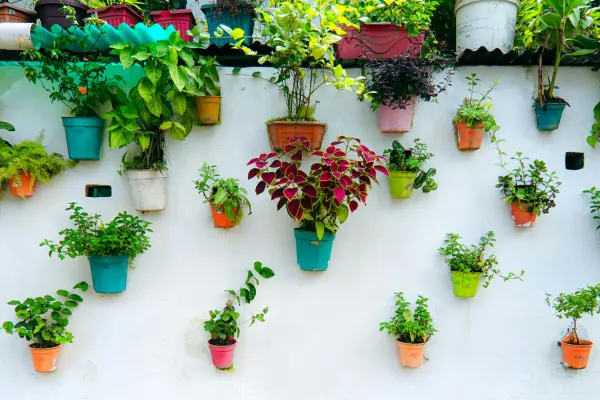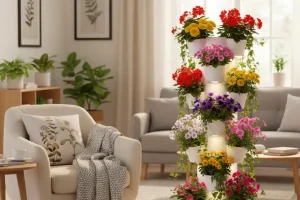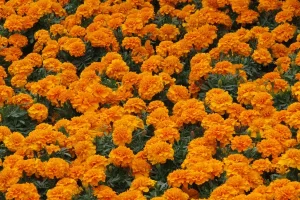Flowers bring life, color, and joy to any space, but arranging them creatively can transform a plain garden wall or balcony into a true work of art. One of the most elegant ways to do this is with floral frames—vertical displays that combine gardening and artistry.
Unlike traditional planters, floral frames are designed to look like living paintings. They can be customized to fit small indoor corners, large outdoor walls, or even freestanding garden features. Best of all, you can make one yourself with simple tools and affordable materials.
Why Choose Floral Frames?
Floral frames bring together beauty and practicality in a compact, wall-friendly design. They turn empty surfaces into living art, adding color, texture, and gentle fragrance without taking up floor space. Whether you rent or own, they’re easy to hang, easy to move, and simple to refresh as seasons change or your style evolves.
Floral frames offer:
- Space-saving: Ideal for small apartments, patios, balconies, or narrow hallways where pots won’t fit. One frame can replace several planters.
- Creative expression: Arrange blooms by color, height, or theme—pastels for spring, warm tones for fall, or a simple green-and-white palette for calm spaces.
- Versatility: Use them indoors with bright windows or outdoors on a shaded wall. Choose lightweight frames for renters, or sturdy, weatherproof options for patios.
- Easy updates: Swap plants every season without a full redesign. Tuck in seasonal accents like trailing ivy, mini ferns, or flowering annuals for fresh looks.
- Healthy indoor vibe: Plants can soften acoustics, boost mood, and make compact rooms feel more welcoming.
- Simple care: Self-watering inserts or drip lines keep maintenance low; a quick weekly check for moisture and spent blooms is often enough.
- Budget friendly: Start small with a single frame and add more over time for a gallery-wall effect.
For vertical garden enthusiasts, floral frames are a natural next step—elegant, flexible, and surprisingly productive in even the tiniest spaces.
Step 1: Gather Materials
You don’t need expensive equipment to get started.
Basic supplies:
- Wooden picture frame, shadow box, or custom frame
- Chicken wire or mesh backing
- Landscape fabric or coir matting
- Potting mix (lightweight, well-draining)
- Staple gun, nails, or screws
- Assorted flowering plants (compact or trailing varieties)
Optional upgrades:
- Built-in drip irrigation for low maintenance
- Decorative paint or finishes for your frame
Step 2: Build Your Frame
- Prepare the backing: Attach chicken wire or mesh securely to the back of the frame.
- Add planting medium: Line with landscape fabric or coir, then fill with soil.
- Secure the surface: Staple another layer of mesh lightly over the soil to hold plants in place.
- Angle for planting: Lay the frame flat while you add plants so soil doesn’t shift.
Step 3: Choose Flowers for Your Frame
Compact flowers with shallow root systems work best.
Top choices for floral frames:
- Petunias & impatiens – bright, long-lasting blooms.
- Pansies & violas – perfect for cooler seasons.
- Begonias & coleus – colorful foliage for contrast.
- Alyssum & lobelia – trailing plants to soften edges.
- Succulent flowers (like kalanchoe) – low-maintenance option indoors.
Step 4: Plant & Arrange Creatively
Think of your floral frame as a canvas.
- Color blocking: Create bold sections of red, yellow, or purple.
- Patterns: Form stripes, circles, or even a checkerboard.
- Seasonal themes: Pastels for spring, bright colors for summer, warm tones for fall.
- Textures: Mix foliage with flowers for depth.
Step 5: Maintain Your Living Artwork
- Watering: Mist frames daily or use drip irrigation. Keep soil moist but not soggy.
- Fertilizing: Use liquid fertilizer every 2–3 weeks to maintain blooms.
- Rotation: Refresh flowers each season to keep displays vibrant.
- Positioning: Indoors, place near bright light; outdoors, adjust for sun/shade based on plant choice.
Quick Floral Frame Design Ideas
| Theme | Suggested Flowers | Style |
| Bold & Bright | Petunias, marigolds, zinnias | Energizing, summery |
| Soft Pastels | Impatiens, pansies, begonias | Romantic, springtime |
| Cool Tones | Lobelia, violets, alyssum | Calming, elegant |
| Mixed Foliage | Coleus, succulents, ivy geraniums | Textured, artistic |
Common Mistakes to Avoid
- Using heavy soil – causes frames to sag and plants to rot.
- Overwatering – especially indoors, frames need careful moisture balance.
- Planting large-rooted flowers – they crowd others out and distort the frame.
- Skipping seasonal updates – tired plants make displays look messy.
FAQs
Q: Can I hang floral frames indoors?
Yes. Choose low-light flowers or add grow lights. Just protect walls from water with a backing tray.
Q: How long do floral frames last?
Frames can last for years if maintained. Plants may need replacing each season.
Q: Can floral frames be freestanding?
Yes. You can mount them on stands or easels for use in gardens or patios.
Q: Do I need special irrigation?
Not required, but drip systems make maintenance easier for large frames.
Next Steps & Related Reading
If you’re inspired by floral artistry, read Designing a Color-Blocked Vertical Flower Garden for more creative layout ideas.
To keep blooms lasting longer, explore How to Extend Bloom Time in Your Vertical Flower Tower.
Conclusion
DIY floral frames are a beautiful way to combine creativity and gardening. With the right frame, flowers, and design plan, you can create a living artwork that changes with the seasons and adds character to any space.
Would you design your first floral frame with bold, eye-catching colors or soft, romantic pastels?




